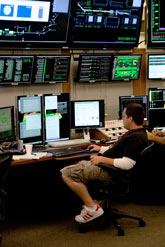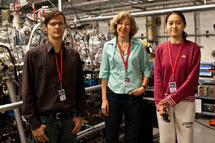
Handy Links
SLAC News Center
SLAC Today
- Subscribe
- Archives: Feb 2006-May 20, 2011
- Archives: May 23, 2011 and later
- Submit Feedback or Story Ideas
- About SLAC Today
SLAC News
Lab News
- Interactions
- Lightsources.org
- ILC NewsLine
- Int'l Science Grid This Week
- Fermilab Today
- Berkeley Lab News
- @brookhaven TODAY
- DOE Pulse
- CERN Courier
- DESY inForm
- US / LHC
SLAC Links
- Emergency
- Safety
- Policy Repository
- Site Entry Form

- Site Maps
- M & O Review
- Computing Status & Calendar
- SLAC Colloquium
- SLACspeak
- SLACspace
- SLAC Logo
- Café Menu
- Flea Market
- Web E-mail
- Marguerite Shuttle
- Discount Commuter Passes
-
Award Reporting Form
- SPIRES
- SciDoc
- Activity Groups
- Library
Stanford
Around the Bay
Behind Every Great LCLS User, Outstanding Beam Operations
University of Western Michigan physicist Nora Berrah wrapped up her research group's five-day run on the Linac Coherent Light Source on October 20. Their project marked the first time that the powerful X-ray laser had been used to study molecules. It was a complex experiment, and Berrah readily acknowledged that the work wouldn't have been possible without the teamwork and cooperation of the LCLS Atomic, Molecular and Optical instrument scientists and engineers.
But she also gave a big nod to another SLAC group that had a more behind-the-scenes role. These were the accelerator operators—the people overseeing the electron beam that drives the LCLS X-ray laser.
"The accelerator operators were absolutely a crucial part of the research team," Berrah said. "We couldn't have done our work without their flexibility in giving us the beam parameters that we requested as well as their interest in our research projects."
The operators craft the LCLS X-ray beam, continually adjusting countless variables to make sure the it meets the specifications of scientists on the other end. But while this role has generally remained the same from one scientific program to the next, the startup of the LCLS has prompted something of a departure in how the operators do business.
For experiments like BaBar, which used SLAC's linear accelerator to drive particle collisions in the PEP-II storage ring, the goal was straightforward: make the beam as bright as possible. For the LCLS, though, users regularly ask for changes in beam parameters, meaning that operators are making more beam changes than they used to.
"With PEP-II, total integrated luminosity was essentially all that mattered. The beam sat at one energy nearly all the time," said Roger Erickson, head of SLAC's Accelerator Operations and Safety Division. "Now, with the LCLS experiments, it's very different. The users are concerned about the beam energy, the pulse length, the instantaneous current, the beam spot size, the beam stability and so on."
The time scales have changed as well. For BaBar, the operators were focused primarily on trying to improve beam luminosity over the course of months are years. Now, with AMO users only working in five-day runs, they have to think in terms of days.
When FACET comes online later this month, operators will have to juggle between two programs simultaneously. Concurrent, parallel programs aren't necessarily new for the operators. During the PEP-II era, they provided beams to both BaBar and the Final Focus Test Beam. The biggest difference now lies in the LCLS. Once all six of the LCLS scientific instruments are installed, it will represent six fully separate experiments, each potentially asking for unique beam parameters.
"With AMO and FACET, I don't expect it to be much different," said Supervisor of MCC Engineering-Operators-in-Charge Mike Stanek. "But once LCLS starts getting lots of photon users at the other end, then it changes."
—Nicholas Bock
SLAC Today, November 10, 2009

